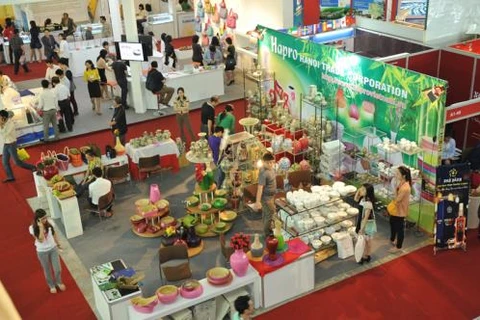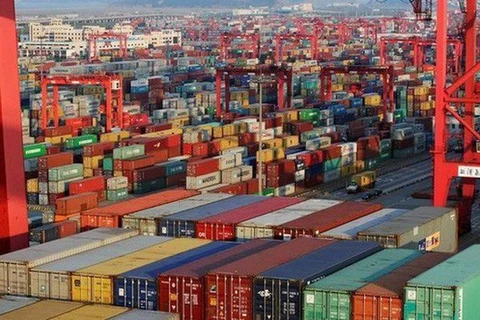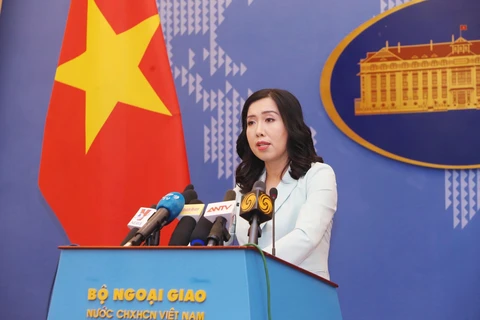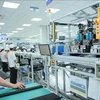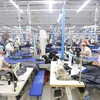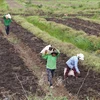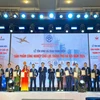Hanoi (VNA) - The Ministry of Industry and Trade (MoIT) has proposed the Government promulgate regulations on Vietnamese goods and ‘Made in Vietnam’ products as there are no specific rules on the issue.
Deputy Minister of Industry and Trade Do Thang Hai made the statement at a press briefing held in Hanoi on July 4, answering questions relating to potential wrongdoings at Asanzo Vietnam Electronics JSC. The firm has reportedly been selling finished products imported from China labelled as “Made in Vietnam” goods.
He said the draft would collect opinions from ministries and people to prevent trade fraud, adding that the ministry has been actively coordinating with the Ministry of Finance (MoF) to clarify the issue.
“Prime Minister Nguyen Xuan Phuc assigned the MoF to act as the focal point to co-ordinate with concerned ministries and agencies, including the MoIT, to inspect and report to the Government. Currently, the two ministries have co-operated in a positive way to implement the direction of the PM,” he said.
Sharing the opinion, Tran Thanh Hai, Deputy Director of the MoIT’s Import-Export Department, said in Vietnam the labelling of goods origin is carried out in accordance with the Government Decree 43/2017. Accordingly, the regulation requires all goods to be labelled. On that label, there is some mandatory information about the name of producers, individuals or organisations and origin of goods.
The Decree also stipulates that enterprises, organisations and individuals circulating goods must determine the information to put on their labels and take responsibility for recording the origin of goods.
However, he said Vietnam has participated in various free trade agreements (FTAs). These agreements contain provisions on goods that enjoy tariff preferences but do not yet have provisions applicable to brands in the domestic market.
He gave an example that Vietnam is participating in the ASEAN free trade area. The condition for granting a certificate of origin is that 40 percent of the content of a product is produced in ASEAN.
“This means that a product can have 10 percent of Thailand, 10 percent of Indonesia, 15 percent of Malaysia and only 5 percent of Vietnam. Thus, we still have not had a clear regulation on how to determine the ratio of goods to be considered Vietnamese goods,” he said.
He added that the ministry would publish the official draft on its websites to collect ideas in the future.-VNA
Deputy Minister of Industry and Trade Do Thang Hai made the statement at a press briefing held in Hanoi on July 4, answering questions relating to potential wrongdoings at Asanzo Vietnam Electronics JSC. The firm has reportedly been selling finished products imported from China labelled as “Made in Vietnam” goods.
He said the draft would collect opinions from ministries and people to prevent trade fraud, adding that the ministry has been actively coordinating with the Ministry of Finance (MoF) to clarify the issue.
“Prime Minister Nguyen Xuan Phuc assigned the MoF to act as the focal point to co-ordinate with concerned ministries and agencies, including the MoIT, to inspect and report to the Government. Currently, the two ministries have co-operated in a positive way to implement the direction of the PM,” he said.
Sharing the opinion, Tran Thanh Hai, Deputy Director of the MoIT’s Import-Export Department, said in Vietnam the labelling of goods origin is carried out in accordance with the Government Decree 43/2017. Accordingly, the regulation requires all goods to be labelled. On that label, there is some mandatory information about the name of producers, individuals or organisations and origin of goods.
The Decree also stipulates that enterprises, organisations and individuals circulating goods must determine the information to put on their labels and take responsibility for recording the origin of goods.
However, he said Vietnam has participated in various free trade agreements (FTAs). These agreements contain provisions on goods that enjoy tariff preferences but do not yet have provisions applicable to brands in the domestic market.
He gave an example that Vietnam is participating in the ASEAN free trade area. The condition for granting a certificate of origin is that 40 percent of the content of a product is produced in ASEAN.
“This means that a product can have 10 percent of Thailand, 10 percent of Indonesia, 15 percent of Malaysia and only 5 percent of Vietnam. Thus, we still have not had a clear regulation on how to determine the ratio of goods to be considered Vietnamese goods,” he said.
He added that the ministry would publish the official draft on its websites to collect ideas in the future.-VNA
VNA

